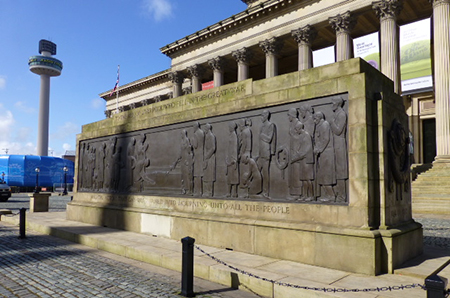
The Liverpool Cenotaph outside St George’s Hall, designed by University of Liverpool architect Professor Lionel Budden in 1930, will become Grade 1 listed, joining just two of similar status across the UK.
An undergraduate from 1905, Professor Budden joined the School of Architecture’s teaching staff in 1911 under the leadership of Professor Charles Reilly. He succeeded his mentor in 1933, leading the discipline until 1952 and, according to current Senior Lecturer Dr Iain Jackson “established how we teach architecture today”.
Modernism and ancestry
Dr Jackson said: “At the time the cenotaph was designed, Professor Budden was trying to promote a style called the Liverpool manner. It was a combination of modernism and ancestry. He was looking for a modern way of designing without completely rejecting the classical tradition.
“St George’s Hall forms the backdrop – can you imagine trying to design something in the shadow of St George’s Hall – but he pulled it off. The pieces of sculpture on either side of it look progressive and quite radical; it looks strong and fits in its context.”
Designed in the form of a vast altar, the bronze reliefs on either side are the work of sculptor, Herbert Tyson Smith. One depicts massed ranks marching off to war. The other, unflinching in its depiction of the scale of loss and grief, shows row upon row of gravestones melting away into the distance and towards eternity; mourners in contemporary dress pay their respects, their solemn faces downcast.
Dr Jackson said: “It wasn’t designed immediately after the war so it wasn’t triumphant or a piece of propaganda, it was more reflective. People lost their lives and that had a direct effect on everybody, not just those who fought. It was also designed during the Great Depression and is perhaps questioning the decadence of the 1920s.”
“Remarkable monument”
The Cenotaph was Grade 2 listed in 1952 but was reassessed by English Heritage as part of a programme to list up to 500 war memorials a year over the next 4 years, to coincide with the centenary of the Great War. The Liverpool Cenotaph joins just two other Grade 1 listed memorials in the UK. The Victoria Park Cenotaph in Leicester, first listed in 1955 and the Cenotaph in Whitehall, first listed in 1970.
Roger Bowdler, Designation Director at English Heritage said: “The Liverpool Cenotaph is a remarkable monument, combining the highest quality of design and artistry with a dignified and painfully poignant memorial to the losses suffered by the people of Liverpool. It fully deserves this designation at the highest grade.”
Professor Lionel Budden also designed the Birkenhead Cenotaph in Hamilton Square, Wirral.